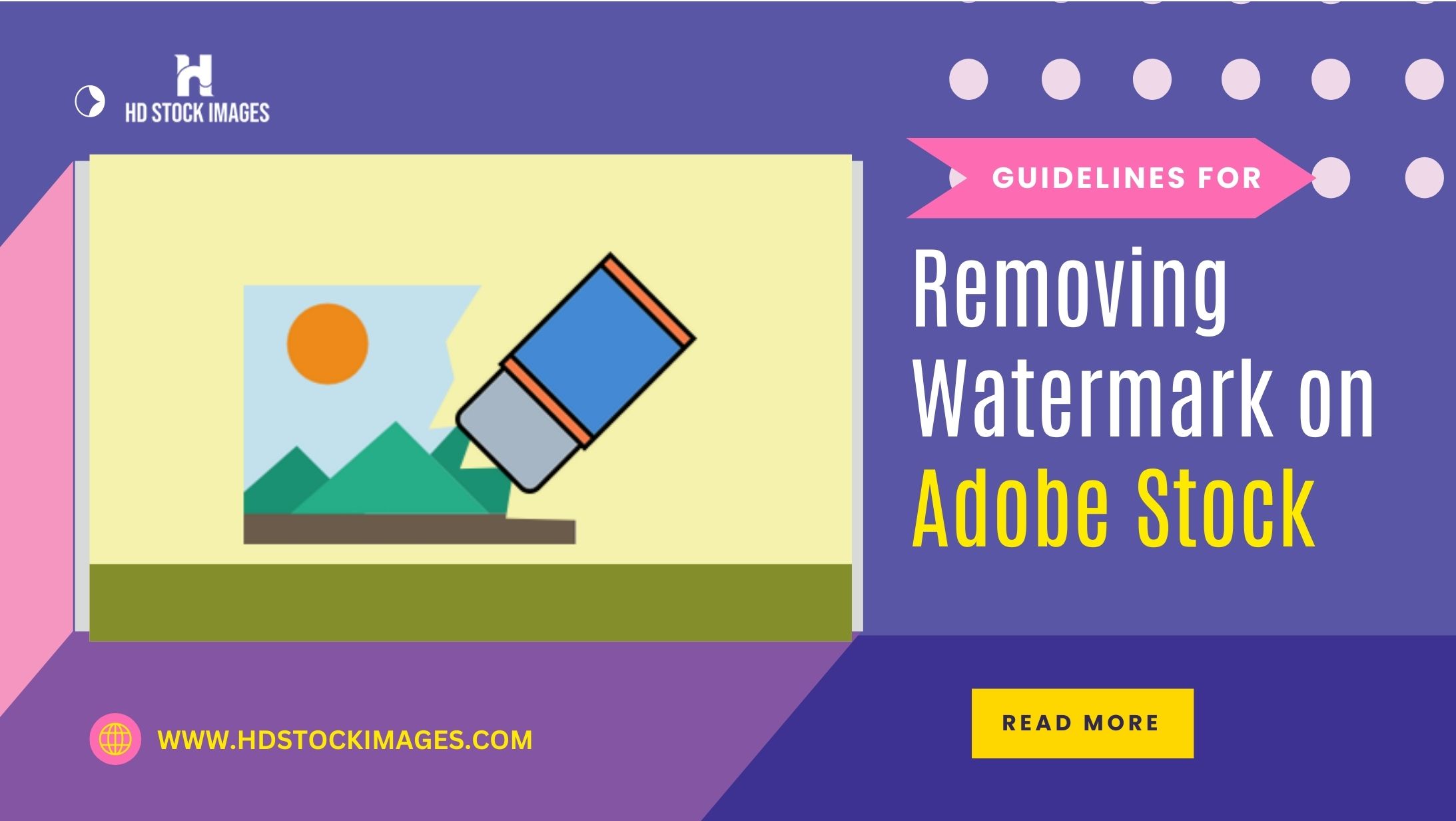Introduction
Watermarks have become a common feature in the world of digital imagery, and
Adobe Stock, as one of the leading
stock image platforms, employs watermarks to protect the copyrights and intellectual property of
content creators. These semi-transparent markings help prevent unauthorized usage and distribution of
images while allowing potential buyers to preview and assess the suitability of the visuals for their projectsThis guide aims to provide comprehensive guidelines and processes for ethically aund legally removing watermarks from images sourced from
Adobe Stock. It is essential to recognize that removing watermarks without proper authorization is a violation of copyright laws and can lead to severe legal consequences. Therefore, this guide will focus on the appropriate scenarios where watermark removal is permissible and the steps to follow to achieve it responsibly. By following these guidelines and processes, users of
Adobe Stock can gain valuable insights into the responsible usage of
watermarked images and the proper channels to obtain high-quality, watermark-free versions for their projects. It is essential to strike a balance between creative freedom and respecting the rights of
content creators, ensuring a fair and sustainable ecosystem for artists and designers alike.
1.Understanding Watermarks

| Aspect | Description |
|---|
| Purpose | Digital markings for copyright protection and ownership attribution |
| Visual Reminder | Serves as a visual cue of image ownership, discouraging unauthorized use or distribution |
| Types of Watermarks | Transparent overlays, tiled watermarks, diagonal watermarks, full-page watermarks, and digital watermarks |
| Adobe Stock Watermarks | Semi-transparent overlays with copyright information or the platform's logo |
| Digital Watermarks | Embedded within image metadata for tracking and identification purposes |
| Main Purposes | Copyright protection and allowing potential buyers to preview images before purchase |
| Strategic Placement | Positioned to avoid obstructing the main subject of the image while remaining visible |
| Standard Practice | Widely used in the stock photography industry to safeguard intellectual property rights |
| Importance for Content Creators | Preserves content integrity and value on Adobe Stock for content creators |
2.Guidelines for Removing Watermarks
When it comes to removing watermarks from images, it is essential to adhere to certain guidelines to ensure ethical and legal practices. Here are the guidelines for removing watermarks responsibly:
1. Legal Implications and Copyright Considerations:
Understand the potential legal consequences of removing watermarks without proper authorization. Removing watermarks from copyrighted content without permission can lead to copyright infringement, resulting in legal penalties.
2. Prohibited Use Cases:
Avoid removing watermarks for unauthorized use or
distribution of images. Respect the rights of
content creators and photographers by not attempting to remove watermarks from images that you do not have proper licensing or permission to use.
3. Identifying Licensed Images:
Be cautious not to remove watermarks from licensed images.
Licensed images have specific usage terms, and removing watermarks from these images can still constitute copyright infringement.
4.Contacting the Copyright Holder:
If you have a legitimate reason to remove a watermark, such as obtaining proper licensing or authorization, reach out to the copyright holder for permission. Seek explicit approval before proceeding with any watermark removal.
5. Responsible Intent:
Ensure that your intention for removing a watermark aligns with ethical practices. Only remove watermarks for authorized purposes, such as
editing images for personal or commercial use with appropriate licenses.
6. Attribution and Compliance:
If you are granted permission to remove a watermark, always adhere to the terms and conditions set by the copyright holder. Provide proper attribution and adhere to any other usage guidelines specified.
7. Respecting Intellectual Property Rights:
Understand and respect the intellectual property rights of photographers and
content creators. Watermarks are essential for protecting their work, and removing them without permission undermines their rights.
8. Using Licensed Images:
Whenever possible,
use images with appropriate licenses from stock photography
platforms like
Adobe Stock. Licensed images allow you to use high-quality content legally and without the need to remove watermarks.
9. Educating Clients and Users:
If you are a
content creator or photographer, educate your clients and users about the significance of watermarks and the importance of respecting copyright and intellectual property rights.
10. Following Platform Policies:
If you are using images from stock photography
platforms, follow their specific watermark usage policies. Each
platform may have its guidelines
for handling watermarked images.By following these guidelines, you can ensure responsible and ethical practices when dealing with watermarked images. Always prioritize respecting the
rights of content creators and photographers while working with digital imagery.
3.Contacting the Copyright Holder
Contacting the copyright holder is an important step when seeking permission to remove a watermark from an image. Here's a guide on how to approach this process:
1. Identify the Copyright Holder:
Determine the rightful owner of the
copyrighted image. This information is usually indicated in the watermark or the image's metadata. If the image is from a stock photography platform like
Adobe Stock, the copyright holder is likely
the platform or the contributing photographer.
2. Find Contact Information:
Look for contact details of the copyright holder. This information can often be found on the copyright owner's website, social media profiles, or the stock photography
platform's contributor information.3. Write a Polite and Professional Email:
Craft a formal and respectful email requesting permission to remove the watermark. Clearly state your intentions and the reasons for wanting to remove the watermark. Explain how you
plan to use the image and assure the copyright holder that you will adhere to their usage terms.
4. Express Gratitude:
Express gratitude for the opportunity to
use the image and acknowledge the copyright holder's creative work and talent.
5. Attach the Watermarked Image:
Attach the watermarked version of the image to the email to give the copyright holder a clear understanding of the
content in question.6. Wait for Approval:
Wait patiently for the copyright holder's response. They may grant permission to remove the watermark, specify conditions for usage, or decline the request.
7. Adhere to Terms and Conditions:
If the copyright holder approves the request, ensure that you follow any conditions or usage guidelines they provide. Properly
attribute the image to the copyright holder as agreed.
8. Respect Their Decision:
If the copyright holder denies your request, respect their decision and do not proceed with removing the watermark.
Seek alternative images with proper licensing and permissions.
9. Keep a Record:
Maintain a record of your communication with the copyright holder, including email exchanges and any agreed-upon terms for future reference.Contacting the copyright holder directly demonstrates your commitment to ethical practices and respect for intellectual property rights. It also provides a chance for open communication and collaboration, fostering a positive relationship between
content users and content creators.This video explains Removing
Watermark on Adobe Stock: Guidelines and Processes:
4.Processes for Removing Watermarks
When it comes to removing watermarks from images, there are several processes and techniques available. It's important to note that the removal of watermarks from
copyrighted images without proper authorization is illegal and unethical. However, there are legitimate scenarios where watermark removal may be necessary, such as obtaining proper licensing or permission. Here are the processes for removing watermarks responsibly:
1. Contact the Copyright Holder:
As mentioned earlier, the first step should be to contact the copyright holder and seek permission to remove the watermark. If granted permission, the copyright holder may provide guidelines or conditions for usage.
2. Professional Editing Services:
Hiring professional photo editing services that specialize in watermark removal can be an option. Experienced editors use advanced techniques to remove watermarks while preserving the
image quality.3. Manual Removal Techniques:
In some cases, watermarks can be removed manually using image editing software like Adobe Photoshop or GIMP. This involves carefully retouching the image to remove the watermark while preserving the overall quality.
4. Third-party Watermark Removal Tools:
There are third-party software
tools available claiming to remove watermarks automatically. However, caution is advised while
using such tools, as they may not always produce satisfactory results and could lead to copyright infringement if used without permission.
5. Using Licensed Images:
The best approach to avoid watermark removal is
to use images with proper licenses from stock photography
platforms like
Adobe Stock. Licensed images can be used legally without the need for watermark removal.
6. Watermarking Metadata:
Instead of visible watermarks, consider embedding copyright information and usage terms into the image's metadata. This way, the information is still present but not obstructing the image.
7. Low-Resolution Images:
For preview purposes, you can provide low-resolution images with watermarks to potential buyers. Once the image is purchased, you can provide the high-resolution version without the watermark.Remember, the removal of watermarks without proper authorization is illegal and can lead to severe consequences. Always respect copyright and intellectual property rights and seek permission from the copyright holder when necessary.
5.Ensuring Ethical Practices
Ensuring ethical practices in the context of removing watermarks involves adhering to legal guidelines, respecting intellectual property rights, and conducting oneself with integrity. Here are the key aspects to consider for ensuring ethical practices:
Frequently Asked Questions
In conclusion,
removing watermarks from images requires careful consideration and adherence to ethical practices. Understanding the legal implications and copyright considerations is crucial to avoid copyright infringement. Seek permission from the copyright holder before removing watermarks, and respect their usage terms and conditions. Always provide proper attribution when using watermarked
images with authorization. Promoting fair use and respecting intellectual property rights contributes to a positive creative community
. Using licensed images from reputable stock photography
platforms eliminates the need to remove watermarks and ensures compliance with usage guidelines. Educate clients and users about the importance of respecting copyrights to foster ethical practices.By following these guidelines, content creators, photographers, and users can contribute to a sustainable and respectful creative ecosystem. Ethical practices ensure that creativity and innovation thrive while safeguarding the work of content creators and photographers.


 admin
admin








